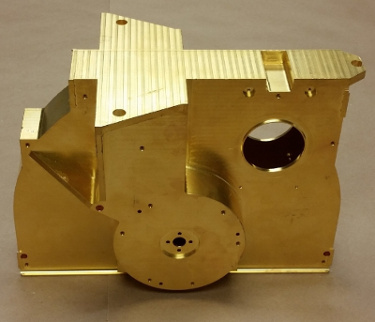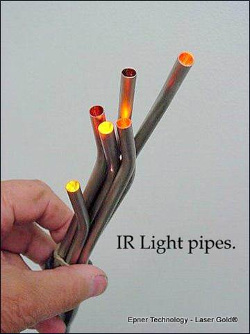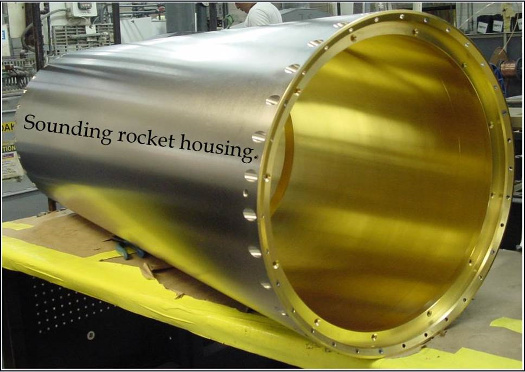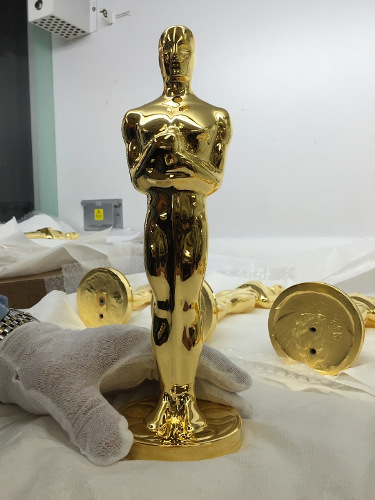 |
| June 14, 2016 | Volume 12 Issue 22 |
Designfax weekly eMagazine
Archives
Partners
Manufacturing Center
Product Spotlight
Modern Applications News
Metalworking Ideas For
Today's Job Shops
Tooling and Production
Strategies for large
metalworking plants
Plating: Where to go when you're going for the (real) gold
When top organizations are thinking about how gold can help enhance a project, they often turn to Laser Gold to solve thermal control problems and enhance performance. Whether it is NASA's desire for 99 percent infrared reflectivity or the "Academy's" wish to make the finish on the historic Oscars statuettes more rugged, Epner Technology's Laser Gold electro-plating process is where it's at.

James Webb Space Telescope titanium filter-wheel housing for NIRCam [Photo: Epner Technology]
NASA was one of the first professional entities to appreciate the innovation Epner Technology brought to gold plating. The space agency required and ultra-pure 24-karat gold to achieve the highest infrared reflectivity. At the same time, the coating had to be rugged enough to permit physical cleaning. The scientists at Epner Technology modified an electrochemical process in such a way that the gold atoms in the deposit were packed more tightly than ordinary plating. And thus Laser Gold was born: the reflectivity of a pure gold combined with the durability of a coating three times harder than any other 24-karat gold.
The James Webb Space Telescope (JWST) engineers at NASA's Jet Propulsion Laboratory have focused on Laser Gold's peerless infrared reflectivity. The Mid Infrared Instrument (MIRI) carried aloft on the JWST has a 16-ft-long cryogenic tube that carries a helium refrigerant at 6 deg K.

IR light pipes are another use for the Laser Gold plating process.
The complete cryogenic system is known as the Refrigerant Line Deployment Assembly (RLDA), and when coiled into its final configuration, it resembles a giant gold "Slinky." The polished Laser Gold finish on the exterior of the stainless coil will efficiently reflect some 99 percent of the sun's intense IR heat energy, thus permitting the camera detector to also achieve and maintain these cryogenic temperatures during the lifetime of this remarkable telescope; indeed a worthy successor to the aging Hubble.
The James Webb Near IR camera (NIRCam) also utilized Laser Gold on more than 20 titanium components.
"Epner's extraordinary gold plating on the filter-wheel housing helped us meet reflectivity, robust bonding, and the high-temperature bake specification on this critical titanium hog-out," said Steven Somerstein, retired program manager, Lockheed-Martin Space Systems. "In addition, Epner coated the NIRCam black-body Lambertian optical integrating cavities with Laser Gold; [which was] used for flat field broadband calibration of the NIRCam infrared focal plane cameras."

Laser Gold was also used on this sounding rocket housing.
For the 2016 Oscars, the Academy of Motion Picture Arts and Sciences (the Academy) decided to return its iconic 8.5-lb award figure to its objet d'art roots. For many years, the Oscar (a knight holding a sword and standing on a film reel) was cast in Britannia metal -- also known as tin. But for the first time in 80 years, the famous 13.5-in. statuette was cast in the original bronze at the well-respected Polich Tallix art foundry in Rock Tavern, NY, and shipped to Epner's Brooklyn facility to be finished in 24-karat Laser Gold for the 2016 awards.

2016 Oscar. [Photo: Epner Technology]
The first step in the process was to polish the raw bronze. Each Oscar was then racked, electro-cleaned, copper plated, bright nickel plated, and immediately immersed in the Laser Gold Plating tank. The entire cycle took more than six hours for each statuette. The durability of this 200-Knoop-hardness process will end the steady stream of Oscars already out there that have been returned to the Academy for re-plating due to the original finish being worn away. Epner, in fact, has guaranteed these Oscars for a lifetime.
For years, Epner Technology had gold-plated many works of some of the world's greatest sculptors, such as Mathew Barney and Jeff Koons. The works of many of these artists were cast at the Polich Tallix art foundry, and the Academy realized that this team of two unique fabricators should be kept intact.
Artists, innovators, engineers, and our country's space programs all have discovered that Laser Gold is, indeed, no ordinary gold.
Get a quick overview of the many applications for Laser Gold by going to the company photo gallery here.
While precious metals and especially gold plating has been the focus at Epner Technology, electroless nickel and all base metals are an integral part of any plating operation.
See a list of metal that the company plates here.
Source: Epner Technology
Published June 2016
Rate this article
View our terms of use and privacy policy
